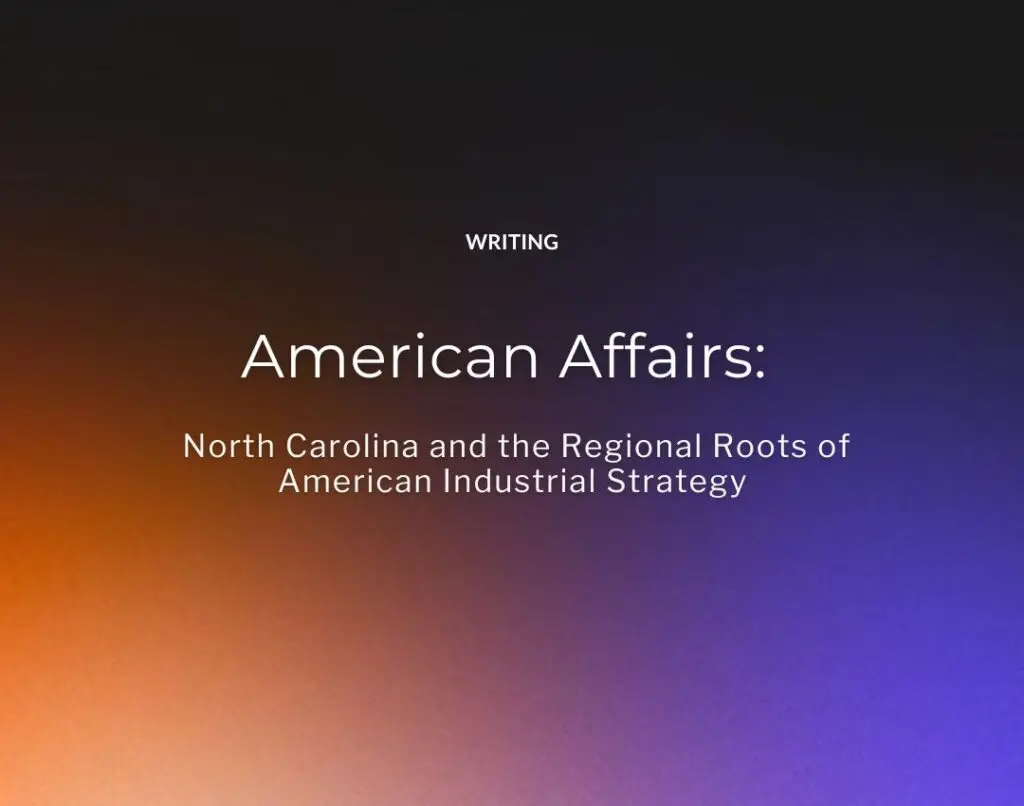by Geoffrey Cain
American Affairs
Summer 2023
he engine of innovation exists in space and quiet. The North Carolina Biotech Center is nestled behind layers of birch trees, on a spacious modernist campus where rustling leaves and birds pierce through the silence. The noisy city-goer wouldn’t realize this is one of the leading hubs of American innovation, with semiconductor fab plants and biotech laboratories hidden behind layers of forest.
The idea of the “tech hub” calls to mind Silicon Valley, Austin, and Miami. But the North Carolina Research Triangle predates all these as the original tech hub, and continues to grow despite being lower-key. In 2022, Research Triangle start-ups raised $22.2 billion in venture capital—a record high in the face of a national slowdown. In October 2022, the American Growth Project ranked the Triangle the fourth-fastest-growing extended city out of fifty, with more than $1 billion in construction and Apple and IBM hiring more than four thousand people, while the rest of the industry was hit with layoffs. From 2015 to 2019, North Carolina created more than 170 start-ups.
The North Carolina Research Triangle got its name due to its “triangle” of three cities—Raleigh, Durham, and Chapel Hill—in an area anchored by three research universities: Duke University, the University of North Carolina at Chapel Hill, and North Carolina State University. Often overlooked in discussions of industrial policy, the region is among America’s most prosperous areas, despite being among the nation’s poorest only two generations ago.
I joined a group of biotech industry executives here in November 2022 for a meeting with Biden administration officials, who had dispensed $25 million as part of a Build Back Better grant. The excitement was palpable. How did a region of cigarette tycoons and destitute tobacco growers emerge as the nation’s nexus for biotech, advanced manufacturing, and research and development in a mere generation? The invisible hand didn’t move prosperity to North Carolina; this can hardly be called a success of the free market. The answer was good government and good planning in ways that were friendly to private business and the nation’s top R&D talent. These efforts allowed for a healthy local market in talent, capital, and innovation to take hold and prosper.
As America looks to rebuild its industrial power, the Research Triangle is emerging as one of the greatest hubs. “During the pandemic, we were as a country kind of held hostage by other countries,” Doug Edgeton, head of the North Carolina Biotechnology Center, a local industry development organization, told me in his office. “As companies produced the vaccine, suddenly we couldn’t get enough little things. Rubber stoppers go in vials, and suddenly we couldn’t get rubber stoppers. PPE [personal protective equipment] was also a big deal.”
The industrial lessons of the Triangle have since saved countless American lives, and the region is only gearing up for more action as the U.S. government more systematically pursues industrial policy. “We already produce a lot of vaccines, so we knew how to produce them.”
Industrial Strategy for America Today
The phrase “industrial policy” is dry, dull, and vague. It conjures up images of miserable workers toiling away to fill widget quotas which they must report to the Communist Party Committee, led by uniformed apparatchiks who convene nearby in a planned district of smokestacks and steel mills. It calls to mind the Soviet Union, China, Japan, and South Korea, which have all executed industrial planning with varying degrees of success. Unlike the United States, all these countries had traditions of authoritarianism that encouraged top-down economic models.
That style of top-down industrial policy, critics say, doesn’t align with America’s decentralized and federated republic. The primacy of local and state politics simply doesn’t give much room to centralized economic decision-making. But as technologists and office workers continue to leave Silicon Valley—thanks to the pandemic, crime, and remote work—America’s regions outside the coasts, everywhere from Madison, Wisconsin, to Greensboro, South Carolina, are seeing a rebirth of technological heartlands.
North Carolina’s Research Triangle shows that industrial planning is, in fact, an American characteristic, not an alien concept from the days of the Soviet Union. The region is an emerging experiment in American industrial policy for the twenty-first century, particularly as the U.S. government begins implementing the chips and Science Act, the largest infusion of cash for semiconductors and R&D since the Apollo moon landings. The renaissance isn’t happening on decrepit factory lines and in sweatshop conditions, but in minimalist, modernist science campuses designed for contemplation and research. From these well-pruned campuses have come major innovations in biotech, software, and semiconductors—including some of the earliest mobile phone technologies, auditory brain implants for the deaf, and the remarkable curing of an hiv/aids patient in 2013.
All this was possible only with a uniquely American flavor of industrial policy, in which private firms cover the costs of their own research with background support from the government, while the state incorporates local governance bodies that prohibit the annexation of land from neighboring municipalities. The result has been a harmonious research zone where lines of state authority are clear but do not overstep into the concerns of private businesses, who are still required to compete with each other. But America’s experiment in industrial strategy is still young, and much remains to be seen as we rediscover our Cold War–era capabilities. “The problem,” a semiconductor strategist tells me, “is that America wants to do industrial policy. But we’re not even in the game yet.” The Triangle, however, shows how we can accomplish it step by step.
The story starts with a chicken-and-egg problem. In the 1950s, the area now called the “Triangle” had few jobs, a poor quality of life, little infrastructure or means of transportation, and no universities or medical centers that could power the research innovations needed for private industry, writes Alex Sayf Cummings, associate professor of history at Georgia State University, in Brain Magnet: Research Triangle Park and the Idea of the Idea Economy (2020), a social and political history of the Triangle.
In all this lies a historical lesson on the dangers of overreliance on tax breaks and subsidies—long an emphasis of the U.S. and state governments. “Southern leaders had been bending over backwards for years to seduce Northern companies with tax incentives and offers to train workers and build facilities,” he writes. “Yet North Carolina’s approach to attracting investment remained limited, for the most part, to promises of infrastructure, such as better roads, and the implicit guarantee of a docile, nonunion labor force, rather than offers of tax breaks.” The result was that investment from Northern companies—who controlled the capital for southern farms and factories at the time—remained limited. Few business owners wanted to invest in North Carolina, despite its promises of a good business environment. They faced the same circular problem as any aspiring tech hub: a city needs jobs to attract talent, but also needs talent to create jobs.
The Research Triangle offers lessons in how to place the right cogs into the machine and then get it moving. By figuring out how to spatially organize cities and suburbs, the Triangle became an exemplar of both urban planning and regional industrial strategy that attracted the interest of federal government procurers. The multistage process was natural and organic, not forced through top-down laws and directives. First, regional planners learned to get universities and medical centers—the R&D lynchpin—on board. Then, they learned how to attract talented knowledge workers, recruiting them from New York and Boston. Finally, they brought in the federal government, which injected the resources that kept the Triangle bustling from the 1960s to the present.
From Tobacco Farms to Biotech Innovation
The story of the Triangle began after World War II, when the American economy was beginning to transform from an industrial age of assembly lines and steel mills to an economy centered around what the management thinker Peter Drucker called “knowledge workers”—scientists, inventors, and thinkers who use their analytical skills to develop products and services. North Carolina’s state leaders realized there was no natural or market-induced path leading to success in this knowledge economy. Achieving the transition was a matter of state planning that would appeal to private businesses. Market forces alone would not guide their impoverished state into the age of the knowledge worker.
They also realized that North Carolina, mired in poverty and failing to catch up to northern industrialization, had an opportunity to seize on the timing of the postwar shift. Federal investment in the defense industry and science R&D had built what President Dwight D. Eisenhower would soon call the “military-industrial complex,” with knowledge-worker settlements emerging in the Sunbelt of Florida, Texas, and California. These large-scale demographic movements also laid the foundations for Silicon Valley as we know it today.
The idea was to capture a piece of the research-industrial complex’s largesse, by getting federal grants. After a decade of modest but respectable growth in the 1950s, the turning point was in 1963, when the Kennedy administration noticed the Research Triangle and gave the federal government the nod to invest in procurement contracts there.
“The North Carolina site is a good one, as there is a triangle there of colleges and hospitals and medical facilities,” President Kennedy said. The federal government built a major environmental health center there, and IBM invested in its first facility in the region. From there, growth took off, thanks to the sound business environment created during the previous decade.
By the early 1980s, the Triangle region had one of the highest concentrations of PhDs in the country—a point that local planners sold to large corporations looking to build new research centers. Keeping this highly-skilled workforce in North Carolina was another matter altogether. The state took advantage of this new affluence and tax revenues to build the first state-supported symphony and the first state museum of art. North Carolina was the first state to use public funds to establish a school for the performing arts. Culture brought vibrancy. It was the bedrock for improved quality of life and appealed to a highly educated and well-paid workforce.
In 1984, six years after scientists first engineered artificial insulin in another state, North Carolina’s state government founded the North Carolina Biotech Center, the serene campus I toured as part of a Biden administration meeting. The Center hoped to seize on earlier strengths and enter the next frontier of industry. The strategy was to fund the recruitment of scientists who would develop ideas, then help transfer technologies from university labs to small companies that could commercialize them, and then give loans to companies to develop those technologies and prove they were worthy of more investment.
The Research Triangle continues to thrive as the result of these multigenerational efforts of government and the private sector working together on R&D. The Triangle should be a blueprint for American industrial policy, as observers are starting to realize. In November 2021, the Peterson Institute for International Economics scored the Research Triangle Park as a leader in industrial policy for the last fifty years under the criteria of making industry more competitive, creating jobs, and advancing technology industries. “Support of public and private R&D has been easily the most successful mode of industrial policy,” the Peterson Institute wrote.
“Companies are making these decisions to open up a research center somewhere, and they want to know, are these people going to help us?” said Edgeton, head of the North Carolina Biotechnology Center. “We try to work together and say, ‘Okay, you need major access to an airport, and you need electric power. And you need this many workers of this kind. And here are the locations in the state of North Carolina.’”
Lessons from the Triangle
What lessons can we learn from the success of the Research Triangle? The first lesson is about properly targeting subsidies to set clear priorities, while letting business lead the way in R&D. The second is about the importance of good spatial and urban planning that’s friendly to R&D-intensive industries and science talent. The third lesson is on how to create a business-friendly environment that lowers costs for businesses while improving the quality of life for high-demand, incoming talent.
Lesson 1: support commercial competition at the frontiers of technology, not “Christmas tree” subsidies. The Triangle shows how the state government can set up an organization with broad governance authority—in this case, the Research Triangle Park Foundation—and use that organization to seed R&D projects with commercial potential. Competing scientists had the resources to pursue the same objective, backed by large research universities. After competition pushed innovation forward, private companies could commercialize their findings without paying royalties to the government, giving them a financial incentive to keep investing in novel ideas.
The U.S. rate of return on public R&D goes as high as 67 percent. But right now, the U.S. government is in danger of damaging innovation if it haphazardly implements the chips and Science Act, the centerpiece of American industrial policy today, which critics accuse of becoming a “Christmas tree” of easy subsidies and tax breaks for bloated and stagnant chip companies such as Intel. On a recent visit to Taiwan, Taiwanese semiconductor executives told me they were frustrated that, while they cooperate with U.S. government requests for more investments in America, the Department of Commerce passes them over for grants and subsidies in favor of bloated, complacent, and obsolescent American chip companies. The U.S. government, they say, is handing easy money to “national champions” that remain generations behind Taiwan’s semiconductor firms—failing to spur any kind of meaningful innovation.
On February 24, even the White House reprimanded Intel, issuing a statement that the chips Act is not supposed to be a fund for struggling companies. The chips Act could fail to seize on America’s great strength of state support for frontier technologies that the private sector can invest in and commercialize once they get closer to marketability. As the World War II–era science administrator Vannevar Bush wrote in his memoir Pieces of the Action in 1970, it’s important to have great minds and thinkers who can innovate from outside traditional bureaucracies, which are prone to repression, but who can enter those bureaucracies when they’re needed. The same holds true for American industrial strategy today: the government must help but must also force companies to compete on their own.
Lesson 2: spatial and urban planning is at the core of building industry. The Research Triangle also offers a lesson on the importance of spatial and urban planning as a component of industrial planning. The Research Triangle Park did not appear out of a top-down federal mandate; rather, local planners took advantage of its existing landscape—consisting of three major universities, good highways passing through the area, and several thousand acres of relatively unused land—and then set out to remold the space in a way friendly to high-tech business and knowledge workers.
“We should all bear in mind that we are not selling a factory site,” explained Romeo Guest, a property planner who helped mastermind the Triangle idea, in the fall of 1954. “We are selling available engineering brains, physical research facilities and cultural living conditions.”
Rather than rely on a cacophony of local, competing municipalities with limited resources, North Carolina’s state leaders built a new governance model that unified the Triangle under one authority. The Research Triangle Park Foundation allowed them to plan the area with unprecedented control across the region, and stopped those municipalities from laying claim to any of the land for themselves. Planners eliminated the need for multiple mayors jockeying for investment in their towns, which might have introduced confusion and incoherence into the strategy.
At the core of the Triangle was its “blankness,” writes Cummings in Brain Magnet. “With centralized authority and five thousand acres as their canvas, they could enforce stringent design regulations on a virtually unprecedented scale.” This governance model allowed them to set out to attract those brains with a quiet research setting, a break from the industrial planning projects of the past, which tended to be urban and clumped workers in close spaces. Previously, the typical knowledge worker was crammed in apartments around a corporate headquarters in Manhattan and Boston.
This planning wisdom extends to today, as white-collar employees leave urban centers such as San Francisco and New York, migrating to smaller innovative towns such as Madison, Wisconsin, and here in Raleigh, North Carolina. “The planning of this area was absolutely perfect for its purpose,” a local restaurant owner in Durham, North Carolina, tells me. “We’re seeing more customers because of all the young people moving in from California and New York. There’s more traffic, sure, but the area has a nice amount of space and isn’t too crammed. The towns are designed to welcome the smart people coming in.”
Lesson 3: a favorable business environment, backed by the state, will allow companies to compete for federal contracts and corporate projects. A research park has prerequisites that don’t apply to all cities and regions. The most innovative employers need access to elite science talent and innovative ideas that they can develop and commercialize. A stable of nearby universities and research centers can provide a steady stream of people and ideas. But the best talent will stay after graduating only if their quality of life, job stability, and salaries can justify it—and the best businesses will only open shop if they can hire those people. Reasonably low taxes, cultural activities and recreation, low crime, and good schools all play into the calculus of a successful research park.
In the early days of the Research Triangle, the competition among America’s regions to attract talent and capital was intense. During the 1950s, North Carolina’s elites were anxious about falling behind other southern states, such as Florida and South Carolina, and were under pressure to catch up. North Carolina’s leaders realized they could not target specific companies for subsidies, but that they had to foster a fruitful and profitable business environment. They offered strong state funding to universities, passed “right-to-work” laws that ensured that labor unions did not monopolize the highly skilled workforce, and placed a limit on property taxes.
Jump-started by the defense contracting described above, the growth of the Triangle region has gone largely upward in the decades since then. The recent renaissance of incoming workers and businesses suggests that the Triangle has become the center of a wider resurgence outside “superstar cities” like New York and San Francisco.
As local and state governments compete for growing federal grants, they’ll be faced with their own questions as they set up regional industrial planning efforts. And while the United States has had some success in setting up R&D hubs, it has been less effective at building vibrant manufacturing and production ecosystems, perhaps the greatest challenge of our time. The free market alone will not decide whether these efforts succeed or fail. Good government in support of good business will play the critical role.
The original article can be found here.
See Also:





